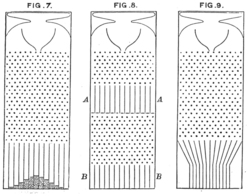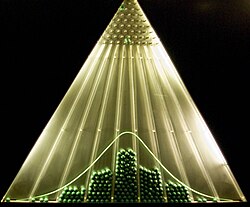Galton board

The bean machine, also known as the quincunx or Galton box, is a device invented by Sir Francis Galton[1] to demonstrate the central limit theorem, in particular that the normal distribution is approximate to the binomial distribution. Among its applications, it afforded insight into regression to the mean or "regression to mediocrity".
Description
The machine consists of a vertical board with interleaved rows of pins. Balls are dropped from the top, and bounce either left or right as they hit the pins. Eventually, they are collected into one-ball-wide bins at the bottom. The height of ball columns accumulated in the bins will eventually approximate a bell curve.
Overlaying Pascal's triangle onto the pins shows the number of different paths that can be taken to get to each bin.
Large-scale working models of this device can be seen in the Mathematica: A World of Numbers... and Beyond exhibits permanently on view at the Boston Museum of Science or the New York Hall of Science.
Distribution of the balls

If a ball bounces to the right k times on its way down (and to the left on the remaining pins) it ends up in the kth bin counting from the left. Denoting the number of rows of pins in a bean machine by n, the number of paths to the kth bin on the bottom is given by the binomial coefficient . If the probability of bouncing right on a pin is p (which equals 0.5 on an unbiased machine) the probability that the ball ends up in the kth bin equals . This is the probability mass function of a binomial distribution.
According to the central limit theorem (more specifically, the de Moivre–Laplace theorem), the binomial distribution approximates the normal distribution provided that n, the number of rows of pins in the machine, is large.
Games
Several games have been developed utilizing the idea of pins changing the route of balls or other objects:
References
- ^ Galton, Sir Francis (1894). Natural Inheritance. Macmillan. pp. 63f.
External links
- A NetLogo simulation and explanation
- Plinko and the Binomial Distribution Interactive simulation
- An 8-foot-tall (2.4 m) Probability Machine (named Sir Francis) comparing stock market returns to the randomness of the beans dropping through the quincunx pattern. from Index Fund Advisors IFA.com
- A simulation with explanations
- Another simulation from John Carroll University
- Quincunx and its relationship to normal distribution from Math Is Fun
- Dynamical turbulent flow on the Galton board with friction
- Animations for the Bean Machine by Lijia Yu using Yihui Xie's R animation package animation
- Pascal's Marble Run: a deterministic Galton board
- Galton-i: board game with chance and tactics


